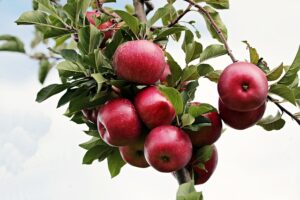Apple trees are a staple of many gardens and orchards, known for their beautiful blossoms and, of course, their delicious fruit. But what many don’t realize is that the key to a fruitful apple harvest lies in successful pollination. Understanding the nuances of apple tree pollination can significantly impact your gardening efforts and yield.
The Importance of Pollination for Apple Trees
Pollination is the transfer of pollen from the male parts of a flower (stamens) to the female part (pistil), leading to fertilization and the production of seeds. For apple trees, this process is not just about reproduction but is essential for fruit development. Without pollination, apple trees may bloom abundantly but will bear little to no fruit.
Types of Apple Tree Pollination: Self-Pollination vs. Cross-Pollination
Apple trees typically fall into two categories regarding pollination needs: self-pollinating (or self-fruitful) varieties and those that require cross-pollination.
- Self-Pollinating Apple Trees can produce fruit with their pollen. However, even these trees can benefit from the presence of another variety for cross-pollination, leading to a more abundant harvest.
- Cross-Pollinating Apple Trees need the pollen from flowers of a different apple variety to produce fruit effectively. This means if you’re planting these types, you’ll need at least two different compatible varieties for successful pollination.
Understanding Diploid and Triploid Apple Trees
When selecting apple trees for your orchard or garden, understanding the terms diploid and triploid is crucial. These terms refer to the number of sets of chromosomes a tree has and significantly affect its pollination capabilities and requirements.
- Diploid Apple Trees have two sets of chromosomes and represent the majority of apple varieties. They can act as pollen donors for other trees and, depending on the variety, might be self-pollinating or require cross-pollination. Diploid trees are essential in an orchard setting as they provide the necessary pollen for both themselves and for triploid varieties.
- Triploid Apple Trees contain three sets of chromosomes and are sterile, meaning they cannot produce viable pollen. While they often yield larger fruit and have good disease resistance, their sterility means they cannot contribute to the pollination of other trees. If you plant triploid apple trees, you must also plant compatible diploid varieties to ensure pollination occurs and fruit sets on all your trees.
Understanding which type you have (or plan to plant) is crucial for ensuring your garden or orchard is set up for success.
Cultivar that are triploid
Understanding the Apple Tree Life Cycle and Its Impact on Pollination
The life cycle of an apple tree influences its pollination needs and capabilities. In spring, apple trees blossom, providing the perfect opportunity for pollination to occur. This period is critical, as the conditions during bloom can greatly affect the pollination process.
Best Practices for Attracting and Supporting Pollinators
Creating an environment that attracts natural pollinators is essential for the cross-pollination of apple trees. Bees are the most effective pollinators for apples, so fostering a bee-friendly garden can significantly enhance your pollination success. Planting a variety of flowers that bloom at different times of the year can help attract and sustain bees in your garden or orchard.
Hand Pollination of Apple Trees: Timing and Methods
While relying on nature is ideal, sometimes hand pollination is necessary to ensure your apple trees are adequately pollinated. This can be particularly useful in areas with fewer natural pollinators or for isolated trees. The process involves manually transferring pollen from one flower to another, mimicking the work of bees.
Tips for Maximizing Pollination Success and Increasing Fruit Yields
- Plant Compatible Varieties: Ensure you have compatible varieties for cross-pollination. Research the best pollinators for your specific apple tree variety.
- Encourage Natural Pollinators: Besides planting flowers, consider installing bee houses or leaving a source of water out for bees.
- Monitor Bloom Times: Keep track of your apple trees’ bloom times to ensure overlapping periods for cross-pollination varieties.
- Practice Proper Tree Care: Healthy trees are more likely to produce abundant, high-quality fruit. Regular watering, fertilizing, and pruning contribute to the overall health and productivity of your apple trees.
Conclusion: The Crucial Role of Pollination in Apple Tree Health and Productivity
Pollination is not merely a part of the apple tree’s lifecycle; it’s a critical element that directly influences the health and productivity of your trees. By understanding the types of pollination, the life cycle of apple trees, and how to attract or manually aid pollinators, you can significantly improve your chances of a bountiful apple harvest.
We encourage you to share your experiences and tips on apple tree pollination in the comments below. Whether you’re a seasoned gardener or new to the world of fruit farming, we’d love to hear about your successes and challenges with apple tree pollination. Together, we can cultivate a thriving community of knowledgeable and passionate growers.

